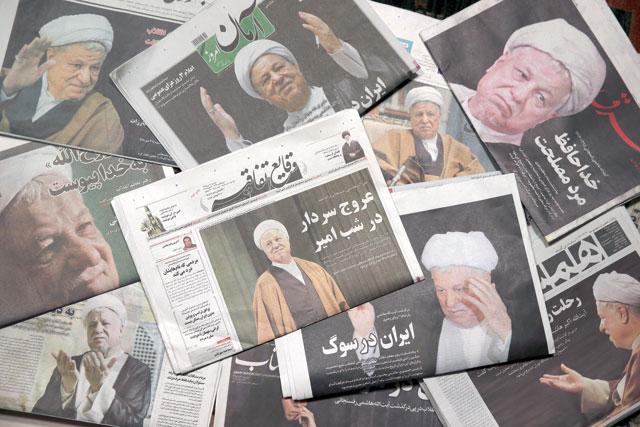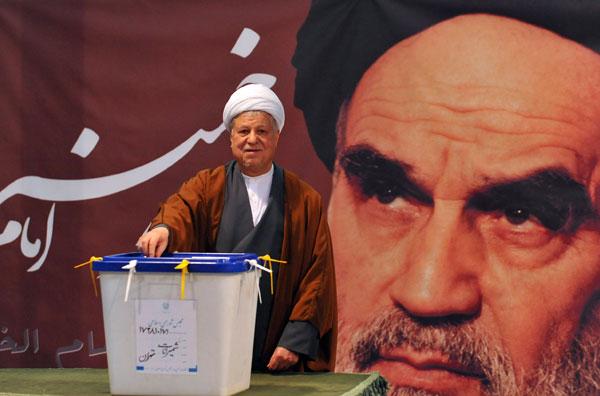You are here
Iran at crossroads 25 years after Khomeini
By AFP - Jun 04,2014 - Last updated at Jun 04,2014
TEHRAN — A quarter of a century after Ayatollah Ruhollah Khomeini’s death, Iran remains at a crossroads in navigating its way out of economic and diplomatic troubles, against a backdrop of political infighting.
Wednesday marks 25 years of the Islamic republic without its founder, the charismatic spiritual and political leader who remains ever-present on bank notes, portraits in public offices and countless posters.
Khomeini is held in awe by the revolutionaries for toppling a US-backed dynasty, with the stated mission of ridding Iran of what he deemed Western decadence and poisonous corruption in government.
The Islamic state that was founded in 1979 on a vision of establishing a Muslim democracy lives on, but the country faces daunting challenges, analysts say, as it grapples with major economic pain.
Dina Esfandiary, an Iran expert at the International Institute for Strategic Studies, believes Tehran’s regional influence has taken a beating, with support for its traditional ally Syria, which is engulfed in a civil war, proving exhausting.
Palestinian Islamist movement Hamas is also distancing itself, she said.
Iran’s power in the modern Middle East stemmed from its steady economic growth in the late 1990s and early 2000s, the fruit of policies implemented by two presidents before Mahmoud Ahmadinejad.
Accused of economic mismanagement, Ahmadinejad, who was in office from 2005 to 2013, wrenched backwards. His populist policies and distribution of Iran’s wealth took the form of cash handouts in a controversial scheme that slashed subsidies.
That practice severely weakened the economy, Tehran-based analyst Saeed Laylaz said, prior to the strengthening of a harsh sanctions regime by world powers designed to coerce Iran into curbing its disputed nuclear drive.
“With no strong economy comes no geopolitical influence,” Laylaz said.
When Khomeini died in 1989, the country was grappling with the aftermath of an eight-year war with Saddam Hussein’s Iraq, during which Iran’s economy was isolated.
Tehran was also trying to find a role on the international stage after descending on a path hostile to Western countries, particularly the United States, aggravated by dismay at their military support for Baghdad.
Today, President Hassan Rouhani faces a similar task in mending fences with the world after eight years of Ahmadinejad’s destructive foreign policy, which drove Iran into diplomatic wilderness and close to the edge of war.
Rouhani says the solution to Iran’s woes lies in bolstering a stagnant economy, which is struggling with double-digit unemployment and inflation, by resolving the decade-long nuclear standoff and proving to the world that Tehran’s atomic programme is peaceful.
“Inflation has steadily slowed down and Rouhani’s technocratic government is... tackling the task at hand. But he will need to secure significant sanctions relief for his policies to work,” Esfandiary said.
Iran’s self-declared moderate president must also overcome domestic critics of reconciliation with the West and those who view any sort of compromise on what Tehran says are its nuclear rights as a red line.
In addition to navigating frictions within the multifaceted political system, Rouhani is also treading a fine path in implementing a promise of more social freedom, which helped him win the presidency last summer.
While Khomeini rejected the technical means of Western civilisation, Khamenei has warned against the “invasion” of Western cultural values, which he says pose a threat to those of the Islamic republic.
Related Articles
ANKARA — Donald Trump’s victory and the war on the Daesh terror group have given Iran’s hard-line Islamic Revolutionary Guard Corps (IRGC) w
ANKARA — The death of former president Ali Akbar Hashemi Rafsanjani deprives Iran’s reformers of a powerful ally, boosting anti-Western hard
TEHRAN, Iran — Former Iranian president Akbar Hashemi Rafsanjani, a wily political survivor and multimillionaire mogul who remained among th


















